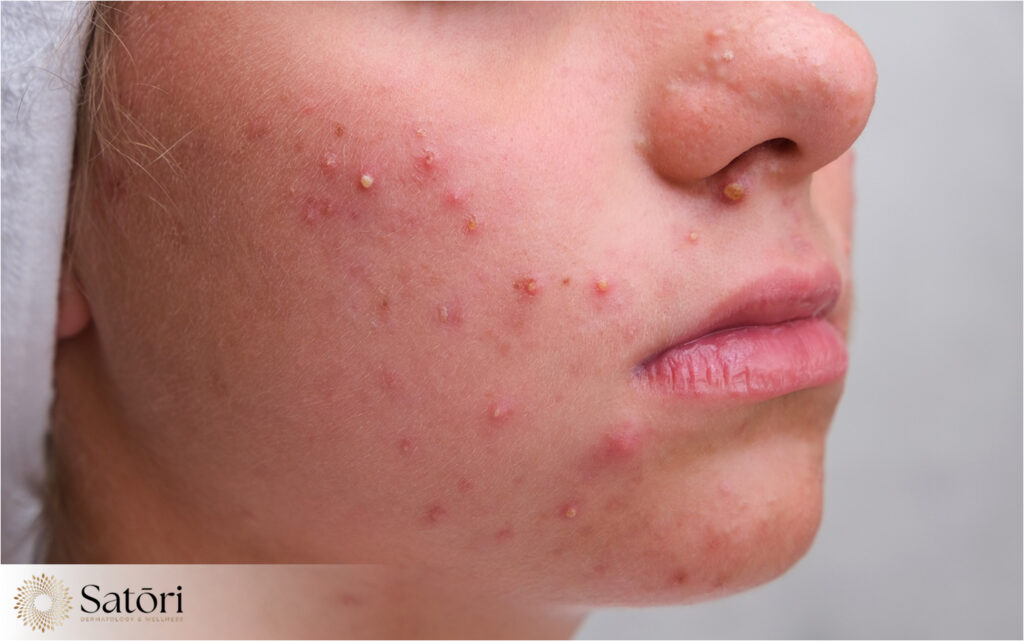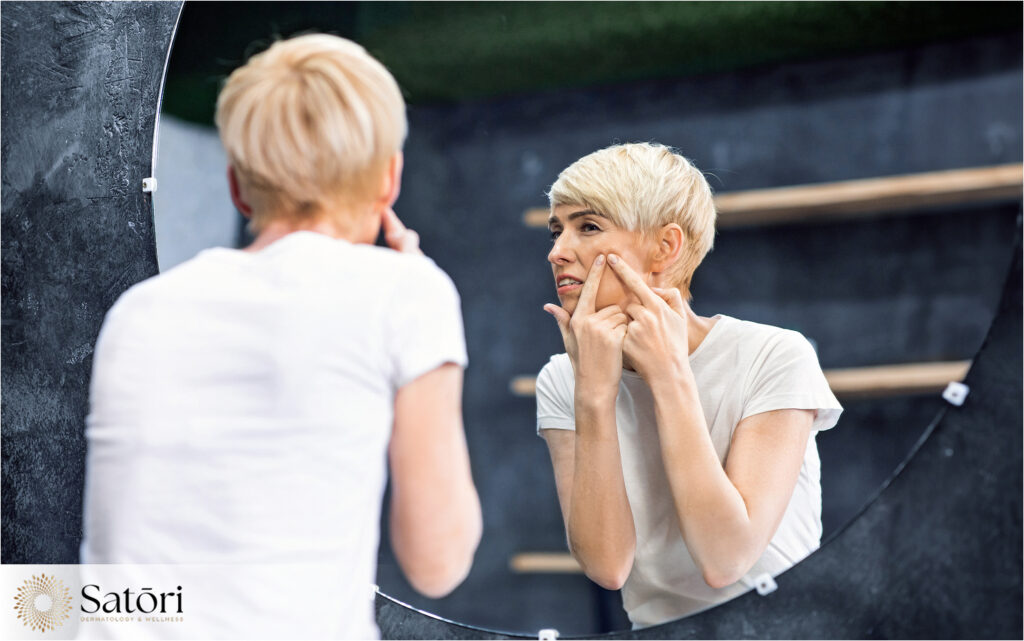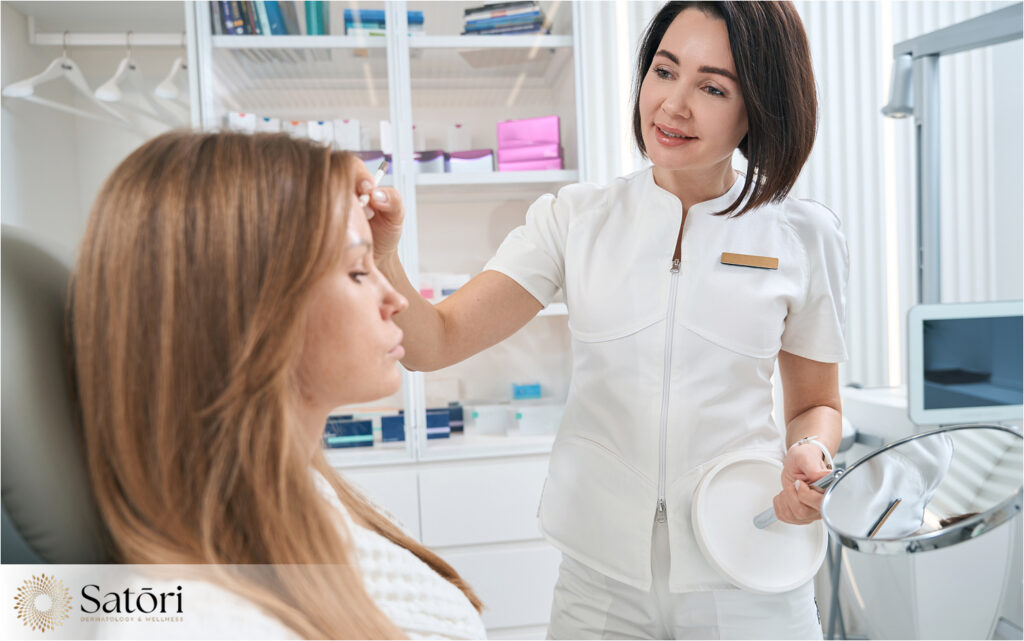Have you ever noticed how your skin seems to break out at the same time each month? Or perhaps you’ve been battling persistent acne along your jawline that just won’t respond to your usual skincare routine? You’re not alone. Hormonal acne affects millions of women, and understanding this common but frustrating condition is the first step toward finding relief.

What Exactly Is Hormonal Acne?
Hormonal acne isn’t just your average breakout. It’s a specific type of acne that’s triggered by fluctuations in hormone levels, particularly androgens like testosterone. While we typically associate testosterone with men, women produce it too—just in smaller amounts. When these hormones fluctuate or increase, they can stimulate oil glands to produce excess sebum, leading to clogged pores and the perfect environment for acne-causing bacteria to thrive.
Unlike teenage acne, which often appears on the forehead and cheeks, hormonal acne in women typically manifests along the lower face—specifically the jawline, chin, and neck. These breakouts tend to be deeper, more painful cystic lesions rather than surface-level whiteheads or blackheads.
Research shows that up to 50% of women in their 20s and 25% of women in their 40s experience acne, with hormonal fluctuations being a primary culprit. It’s a reminder that acne isn’t just a teenage problem—it’s a condition that can affect women at any age.
How to Recognize Hormonal Acne
Identifying hormonal acne is crucial for effective treatment. Here are the key characteristics to look for:
Location Matters
The placement of your breakouts can be very telling. Hormonal acne primarily appears on the lower third of the face—chin, jawline, and around the mouth. This “U-zone” distribution is distinctly different from the “T-zone” (forehead, nose, and central cheeks) breakouts commonly seen in teenage acne.
Timing and Patterns
One of the most significant indicators of hormonal acne is its cyclical nature. Do you notice flare-ups that coincide with your menstrual cycle? Typically, breakouts occur about a week before your period begins, when progesterone levels peak and estrogen drops. This pattern is a strong sign that hormones are driving your acne.
Type of Lesions
Hormonal acne often presents as deep, painful cysts rather than surface-level pimples. These cystic lesions develop beneath the skin and don’t come to a head like typical whiteheads. They’re tender to the touch and can linger for weeks if not properly treated.
Resistance to Conventional Treatments
If you’ve diligently applied topical treatments with little improvement, hormonal factors might be at play. Hormonal acne often doesn’t respond well to traditional acne-fighting ingredients like benzoyl peroxide or salicylic acid alone because the root cause lies deeper—in hormone imbalances rather than just surface bacteria or clogged pores.

Understanding the Root Causes
Several hormonal factors can contribute to acne in women:
Menstrual Cycle Fluctuations
During your monthly cycle, estrogen levels rise during the first half and then drop in the second half as progesterone increases. This shift can trigger oil production and inflammation, leading to breakouts. A 2018 study in the Journal of Clinical and Aesthetic Dermatology found that 65% of women reported worsening acne in the days before their period.
Polycystic Ovary Syndrome (PCOS)
PCOS affects approximately 10% of women of reproductive age and is characterized by elevated androgens (male hormones). These excess androgens stimulate oil glands, often resulting in severe, persistent acne along with other symptoms like irregular periods and excess facial or body hair.
Pregnancy and Postpartum Changes
The dramatic hormone fluctuations during pregnancy and after childbirth can trigger acne flare-ups. While some women experience the “pregnancy glow” with clear skin, others find themselves dealing with unprecedented breakouts due to increased progesterone and androgens.
Perimenopause and Menopause
As women approach menopause, estrogen levels decline while the relative concentration of androgens may increase. This hormonal shift can lead to adult-onset acne, even in women who never struggled with acne before.
Stress Response
When you’re stressed, your body produces more cortisol and androgens, which can stimulate oil production and worsen inflammation. Think of it as a vicious cycle: stress can trigger hormonal acne, and having acne can increase stress levels.

A Multi-Faceted Approach for Expert Solutions
Treating hormonal acne requires a comprehensive strategy that addresses both the symptoms and underlying causes. Here’s what works:
Medical Interventions
- Oral Contraceptives: Certain birth control pills containing both estrogen and progesterone can help regulate hormone levels and reduce acne. The FDA has approved specific formulations like Ortho Tri-Cyclen, Estrostep, and Yaz for acne treatment.
- Spironolactone: Originally developed as a blood pressure medication, spironolactone works by blocking androgen receptors and decreasing testosterone production. Studies show that up to 85% of women see improvement in their acne when taking spironolactone.
- Topical Retinoids: Prescription-strength retinoids like tretinoin or adapalene can help prevent clogged pores and reduce inflammation. They work by increasing cell turnover and preventing the formation of microcomedones—the precursors to all acne lesions.
- Topical Antibiotics: Ingredients like clindamycin can help reduce acne-causing bacteria and inflammation when used in combination with other treatments.
Advanced Skincare Solutions
Creating an effective skincare routine is essential for managing hormonal acne.
- Gentle Cleansing: Wash twice daily with a gentle, pH-balanced cleanser containing ingredients like salicylic acid or glycolic acid to remove excess oil without stripping the skin.
- Strategic Exfoliation: Regular exfoliation with AHAs (like glycolic acid) or BHAs (like salicylic acid) helps prevent clogged pores and reduces the appearance of acne scars.
- Targeted Treatments: Ingredients like niacinamide (vitamin B3) can help regulate oil production and reduce inflammation, while azelaic acid fights bacteria and reduces redness.
- Oil-Free Moisturizing: Even acne-prone skin needs moisture. Look for non-comedogenic, oil-free formulations containing hyaluronic acid or ceramides.
Lifestyle Modifications
Several lifestyle factors can significantly impact hormonal acne.
- Balanced Diet: Some studies suggest a connection between high-glycemic foods (like white bread and sugary snacks) and acne. Incorporating more omega-3 fatty acids, antioxidant-rich fruits and vegetables, and zinc-containing foods may help reduce inflammation. Coffee isn’t a direct cause of hormonal acne, but when combined with sugar or dairy, it may exacerbate breakouts in some individuals.
- Stress Management: Practices like meditation, yoga, or regular exercise can help lower cortisol levels and potentially reduce hormonally driven breakouts.
- Consistent Sleep Schedule: Quality sleep helps regulate hormone production. Aim for 7-9 hours of uninterrupted sleep each night.
Our Approach to Hormonal Acne
At our dermatology practice, we understand that hormonal acne can be physically uncomfortable and emotionally challenging. That’s why we take a personalized approach to each patient’s situation. Rather than prescribing a one-size-fits-all solution, we conduct comprehensive hormone testing when appropriate and develop individualized treatment plans that may combine prescription medications, advanced skincare regimens, and lifestyle recommendations.
Your Path to Moving Forward with Clearer Skin
Hormonal acne may be stubborn, but it’s definitely treatable with the right approach. Here’s what to remember:
- Proper diagnosis is essential. What works for typical acne may not work for hormonal breakouts.
- Be patient with treatment. Hormonal therapies can take 2-3 months to show significant results.
- Consistency matters. Stick with your prescribed regimen even after your skin begins to clear.
- A holistic approach combines medical treatments, skincare, and lifestyle changes for the best results.
If you’re struggling with persistent breakouts, especially along your jawline or chin, or notice a clear pattern with your menstrual cycle, it’s time to consult with a dermatologist who specializes in hormonal acne. Our practice offers comprehensive evaluations and personalized treatment plans to help you achieve clearer, healthier skin.

